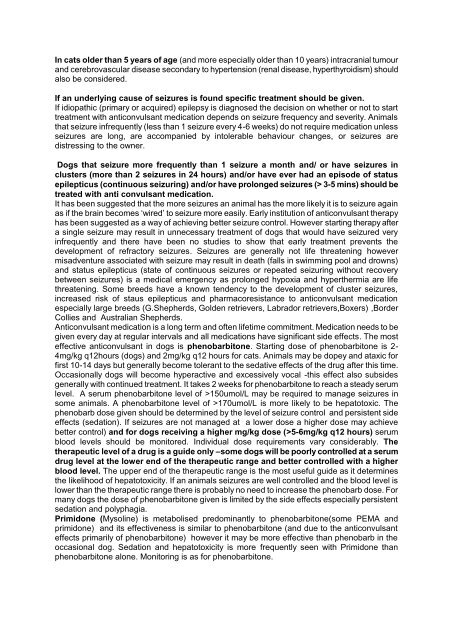Seizure disorders in dogs - Australian Veterinary Association
Seizure disorders in dogs - Australian Veterinary Association
Seizure disorders in dogs - Australian Veterinary Association
You also want an ePaper? Increase the reach of your titles
YUMPU automatically turns print PDFs into web optimized ePapers that Google loves.
In cats older than 5 years of age (and more especially older than 10 years) <strong>in</strong>tracranial tumourand cerebrovascular disease secondary to hypertension (renal disease, hyperthyroidism) shouldalso be considered.If an underly<strong>in</strong>g cause of seizures is found specific treatment should be given.If idiopathic (primary or acquired) epilepsy is diagnosed the decision on whether or not to starttreatment with anticonvulsant medication depends on seizure frequency and severity. Animalsthat seizure <strong>in</strong>frequently (less than 1 seizure every 4-6 weeks) do not require medication unlessseizures are long, are accompanied by <strong>in</strong>tolerable behaviour changes, or seizures aredistress<strong>in</strong>g to the owner.Dogs that seizure more frequently than 1 seizure a month and/ or have seizures <strong>in</strong>clusters (more than 2 seizures <strong>in</strong> 24 hours) and/or have ever had an episode of statusepilepticus (cont<strong>in</strong>uous seizur<strong>in</strong>g) and/or have prolonged seizures (> 3-5 m<strong>in</strong>s) should betreated with anti convulsant medication.It has been suggested that the more seizures an animal has the more likely it is to seizure aga<strong>in</strong>as if the bra<strong>in</strong> becomes ‘wired’ to seizure more easily. Early <strong>in</strong>stitution of anticonvulsant therapyhas been suggested as a way of achiev<strong>in</strong>g better seizure control. However start<strong>in</strong>g therapy aftera s<strong>in</strong>gle seizure may result <strong>in</strong> unnecessary treatment of <strong>dogs</strong> that would have seizured very<strong>in</strong>frequently and there have been no studies to show that early treatment prevents thedevelopment of refractory seizures. <strong>Seizure</strong>s are generally not life threaten<strong>in</strong>g howevermisadventure associated with seizure may result <strong>in</strong> death (falls <strong>in</strong> swimm<strong>in</strong>g pool and drowns)and status epilepticus (state of cont<strong>in</strong>uous seizures or repeated seizur<strong>in</strong>g without recoverybetween seizures) is a medical emergency as prolonged hypoxia and hyperthermia are lifethreaten<strong>in</strong>g. Some breeds have a known tendency to the development of cluster seizures,<strong>in</strong>creased risk of staus epilepticus and pharmacoresistance to anticonvulsant medicationespecially large breeds (G.Shepherds, Golden retrievers, Labrador retrievers,Boxers) ,BorderCollies and <strong>Australian</strong> Shepherds.Anticonvulsant medication is a long term and often lifetime commitment. Medication needs to begiven every day at regular <strong>in</strong>tervals and all medications have significant side effects. The mosteffective anticonvulsant <strong>in</strong> <strong>dogs</strong> is phenobarbitone. Start<strong>in</strong>g dose of phenobarbitone is 2-4mg/kg q12hours (<strong>dogs</strong>) and 2mg/kg q12 hours for cats. Animals may be dopey and ataxic forfirst 10-14 days but generally become tolerant to the sedative effects of the drug after this time.Occasionally <strong>dogs</strong> will become hyperactive and excessively vocal -this effect also subsidesgenerally with cont<strong>in</strong>ued treatment. It takes 2 weeks for phenobarbitone to reach a steady serumlevel. A serum phenobarbitone level of >150umol/L may be required to manage seizures <strong>in</strong>some animals. A phenobarbitone level of >170umol/L is more likely to be hepatotoxic. Thephenobarb dose given should be determ<strong>in</strong>ed by the level of seizure control and persistent sideeffects (sedation). If seizures are not managed at a lower dose a higher dose may achievebetter control) and for <strong>dogs</strong> receiv<strong>in</strong>g a higher mg/kg dose (>5-6mg/kg q12 hours) serumblood levels should be monitored. Individual dose requirements vary considerably. Thetherapeutic level of a drug is a guide only –some <strong>dogs</strong> will be poorly controlled at a serumdrug level at the lower end of the therapeutic range and better controlled with a higherblood level. The upper end of the therapeutic range is the most useful guide as it determ<strong>in</strong>esthe likelihood of hepatotoxicity. If an animals seizures are well controlled and the blood level islower than the therapeutic range there is probably no need to <strong>in</strong>crease the phenobarb dose. Formany <strong>dogs</strong> the dose of phenobarbitone given is limited by the side effects especially persistentsedation and polyphagia.Primidone (Mysol<strong>in</strong>e) is metabolised predom<strong>in</strong>antly to phenobarbitone(some PEMA andprimidone) and its effectiveness is similar to phenobarbitone (and due to the anticonvulsanteffects primarily of phenobarbitone) however it may be more effective than phenobarb <strong>in</strong> theoccasional dog. Sedation and hepatotoxicity is more frequently seen with Primidone thanphenobarbitone alone. Monitor<strong>in</strong>g is as for phenobarbitone.

















